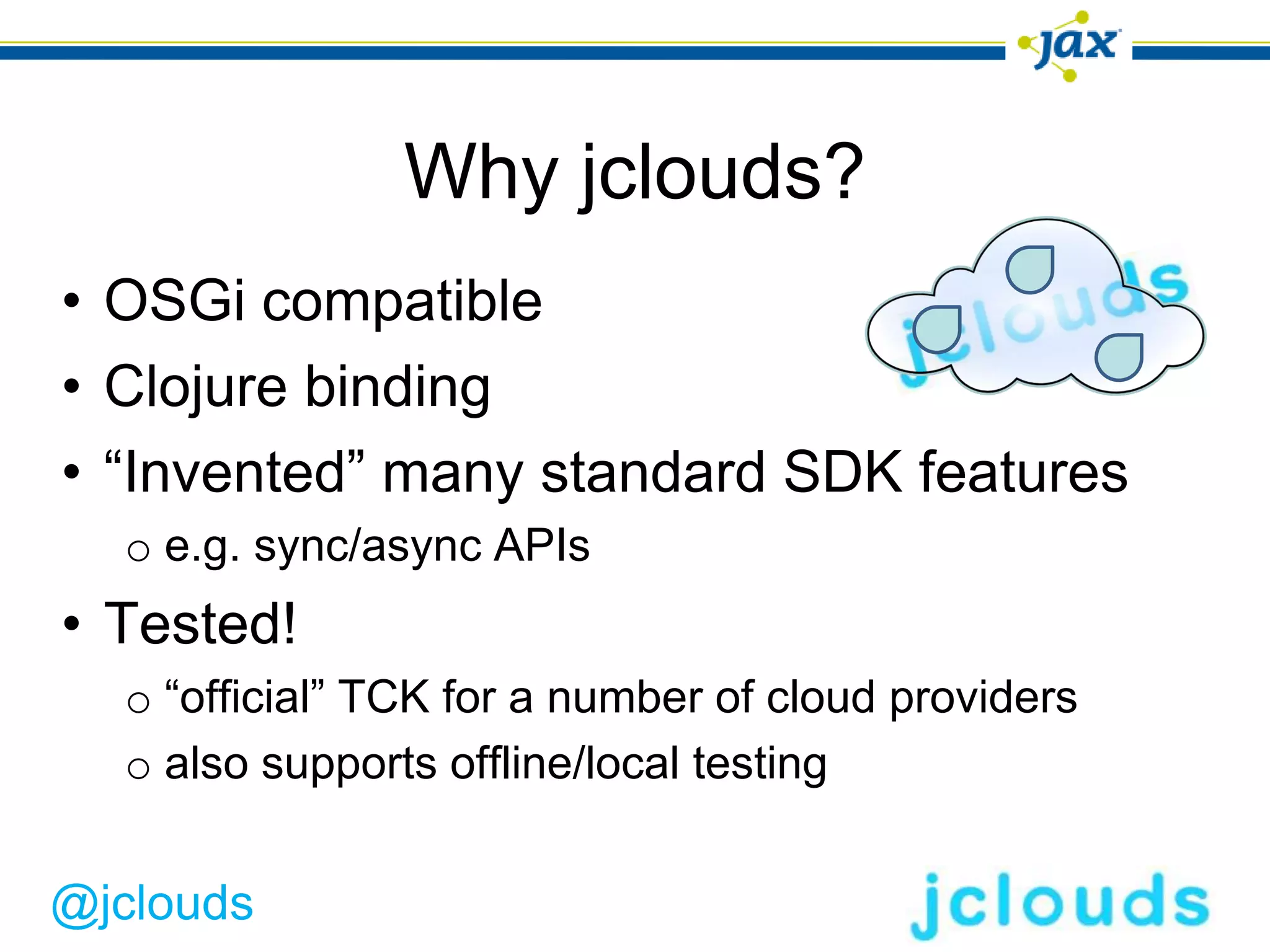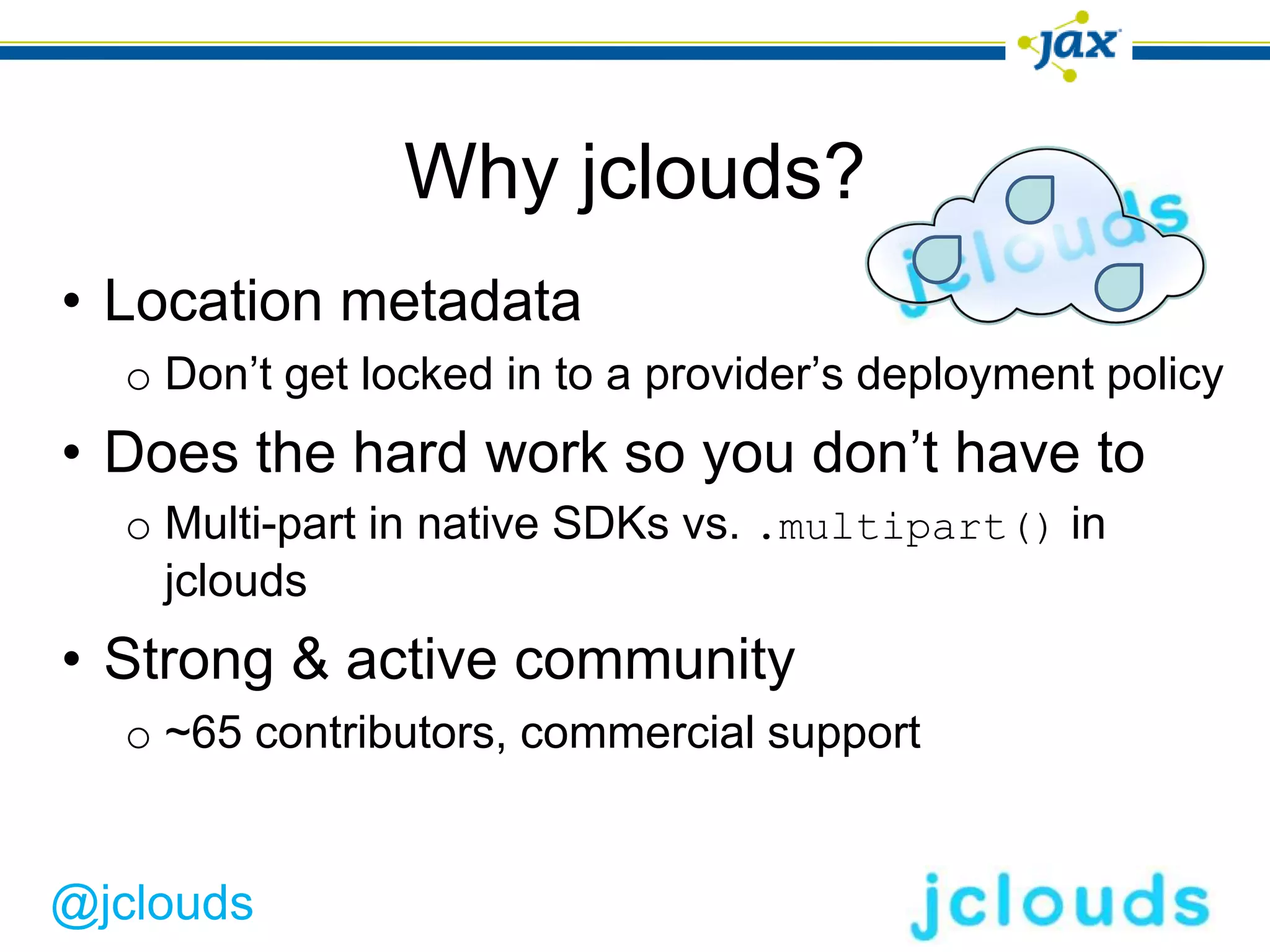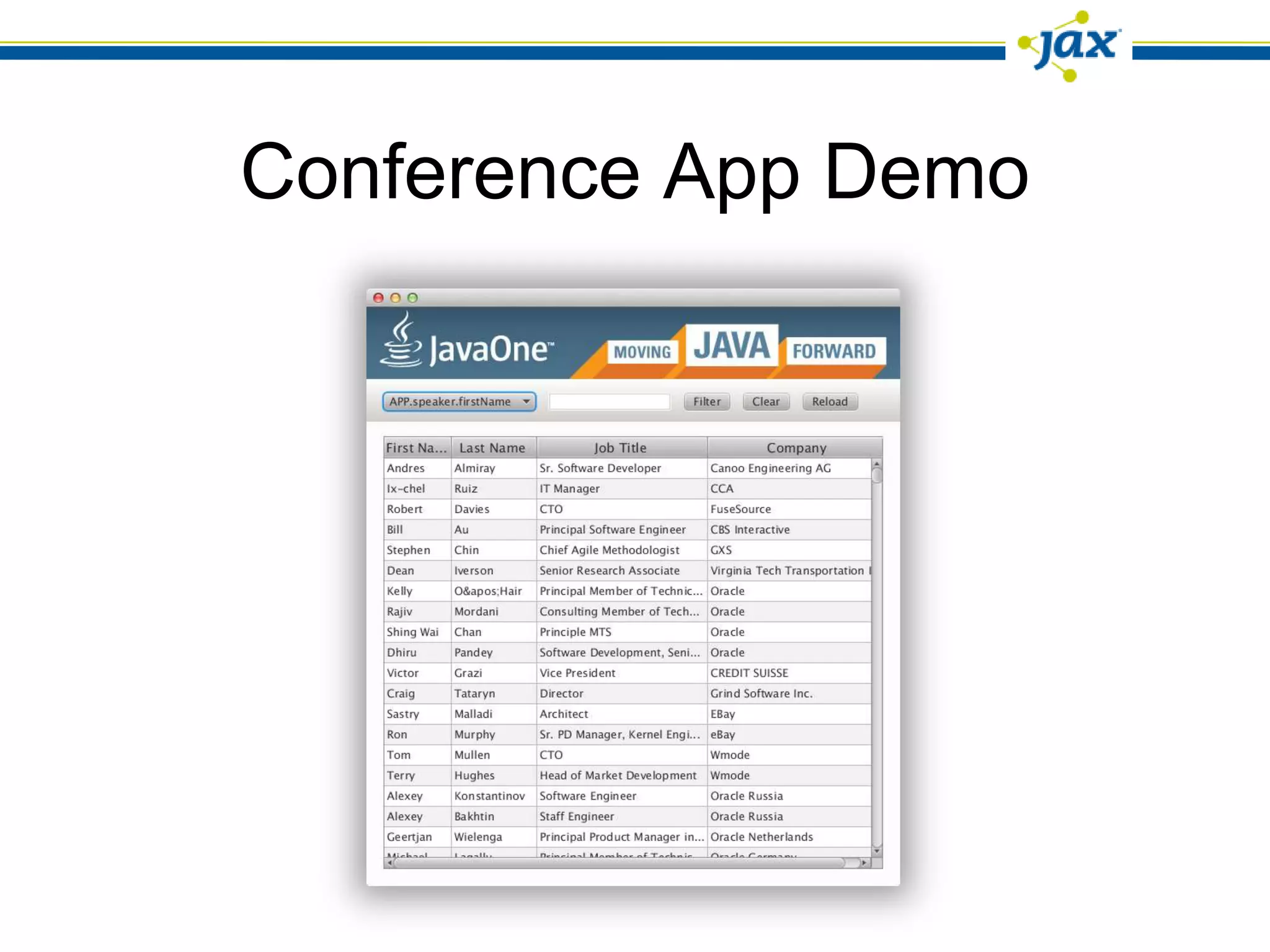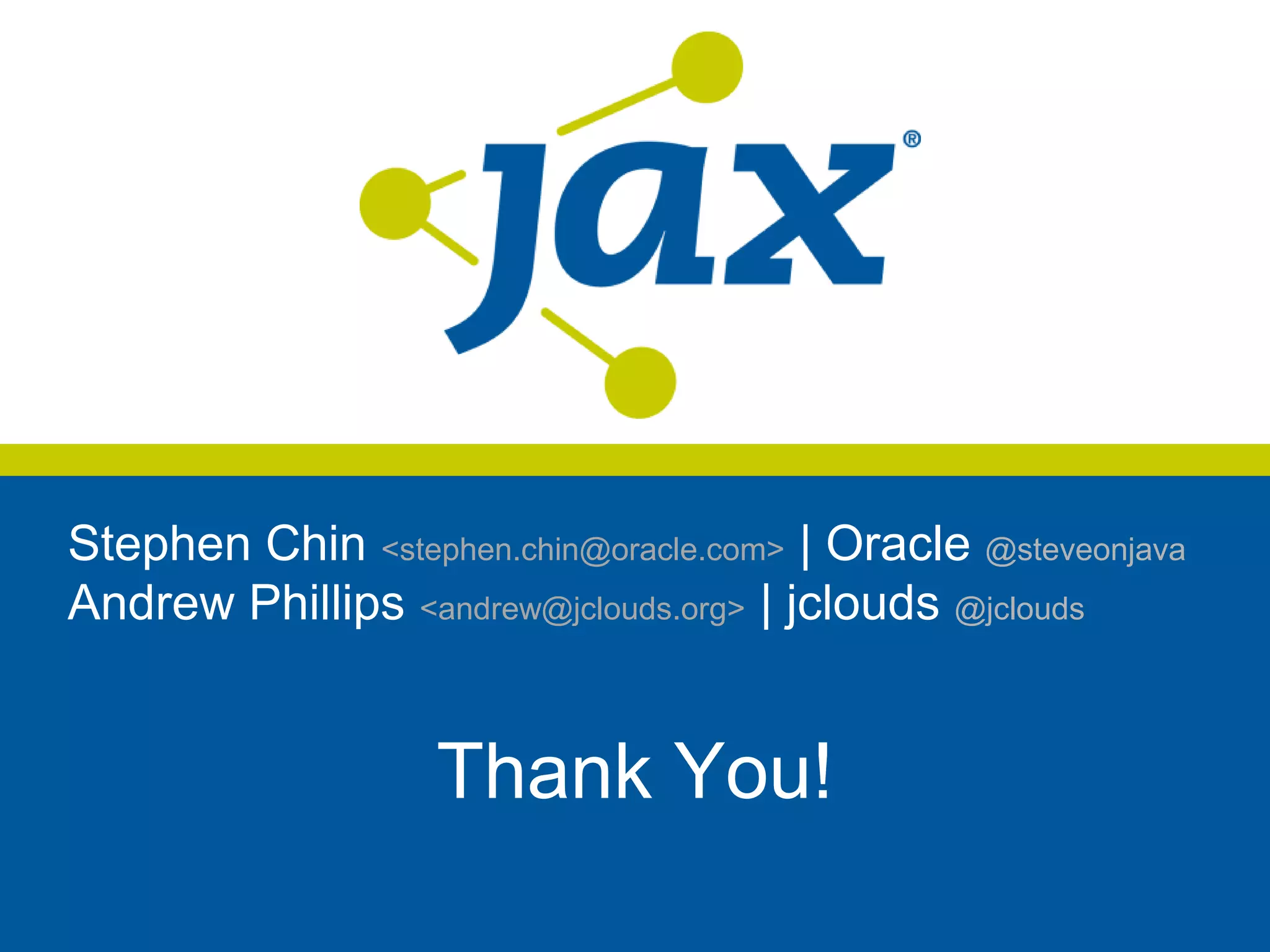The document discusses the advantages of cloud data architectures, highlighting features like offline operation, high availability, and cost-effectiveness, particularly for applications with a limited user view of data. It also examines the benefits of using JavaFX and Scala for developing responsive applications, showcasing their integration and support for immersive experiences. Additionally, it introduces the jclouds API for cloud access, emphasizing its portability and compatibility with multiple providers.
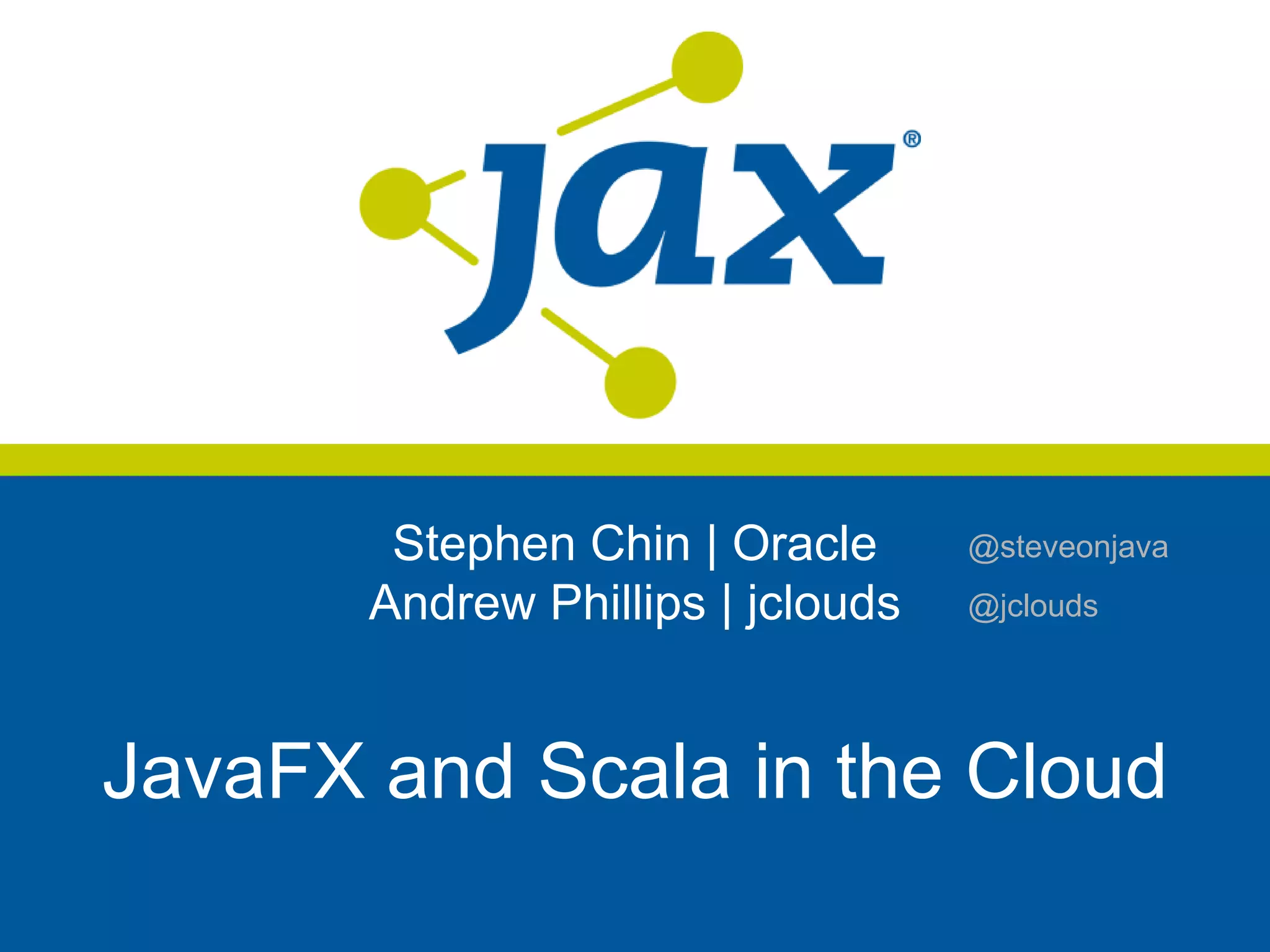
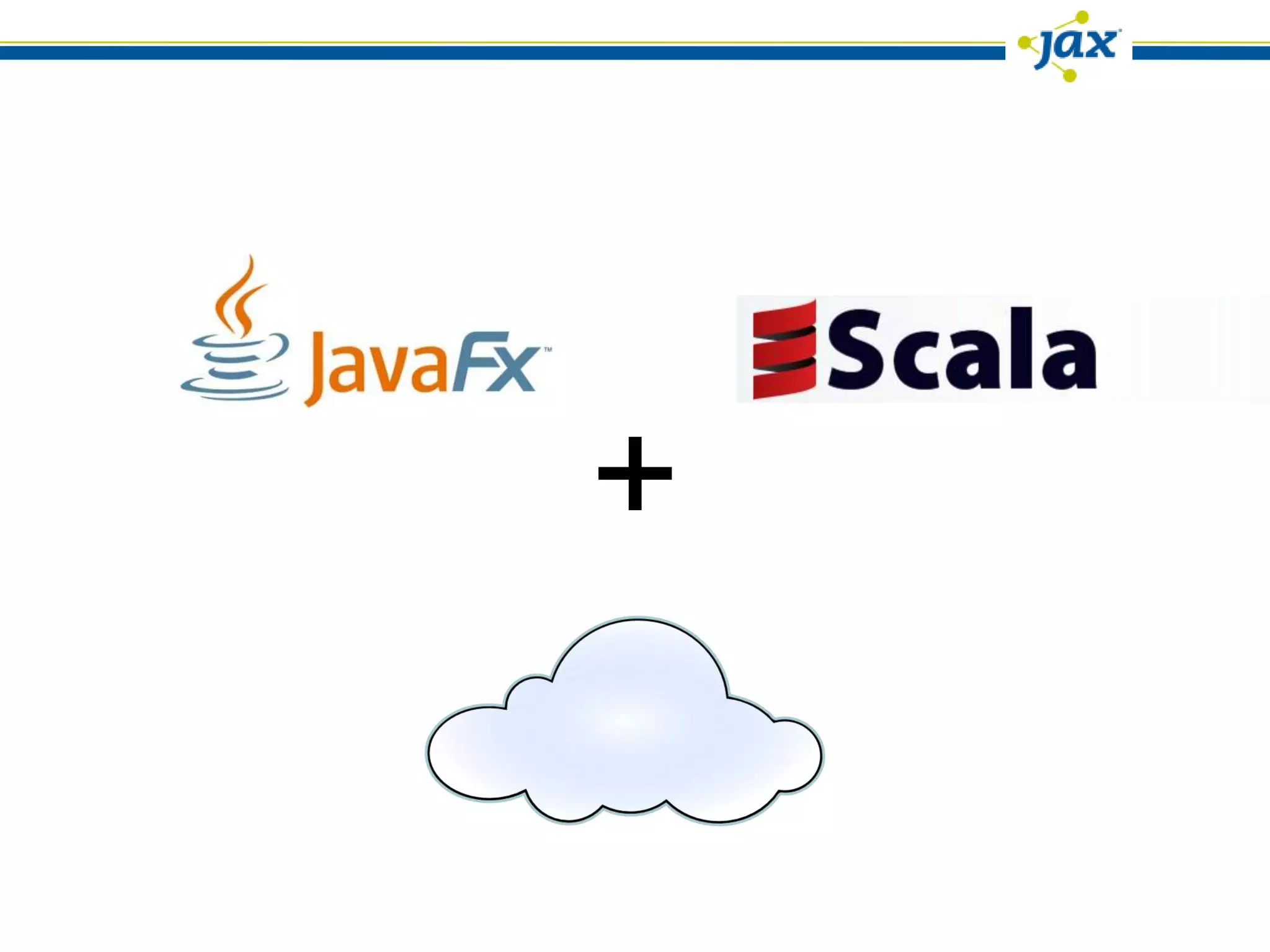

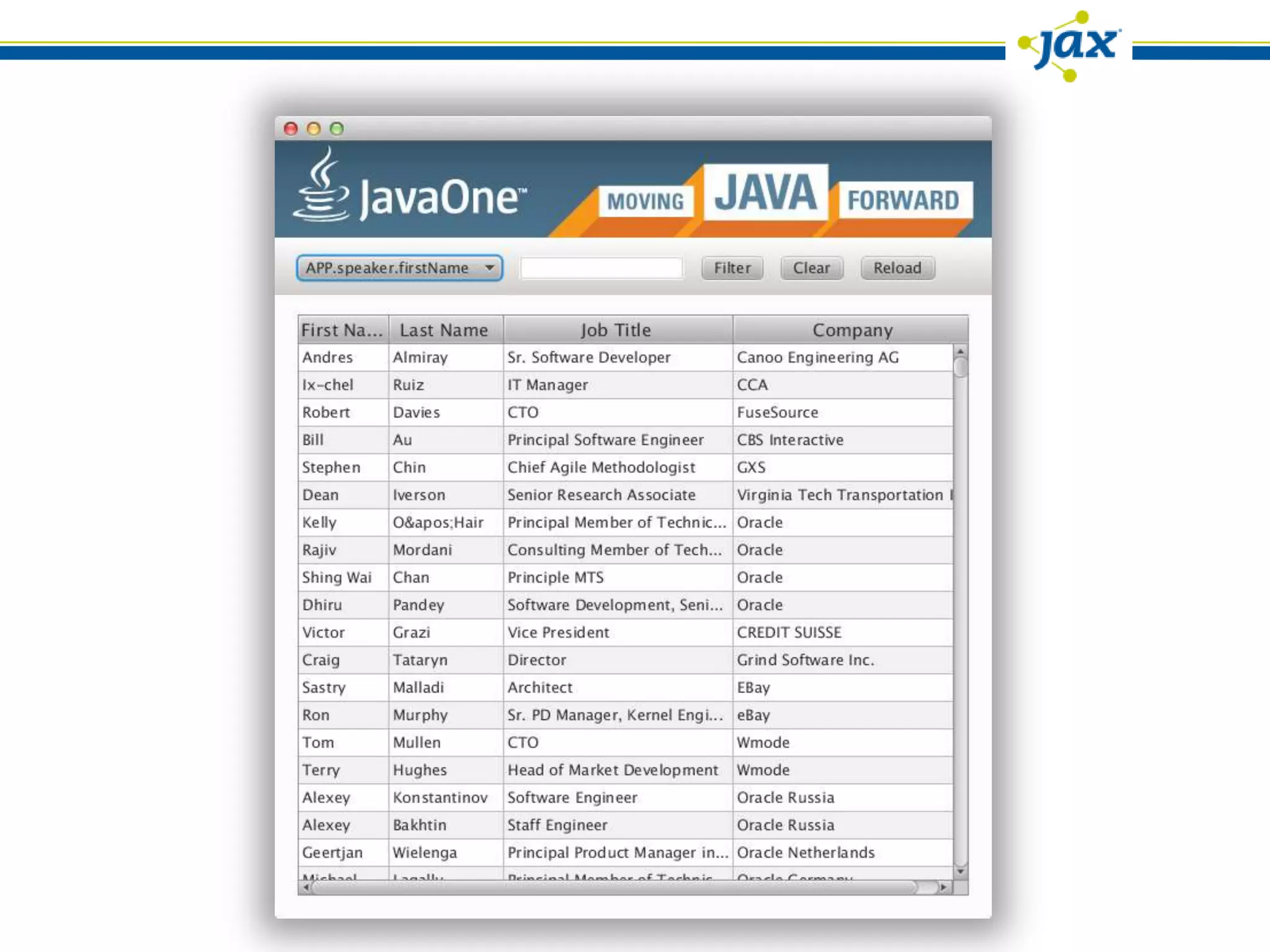
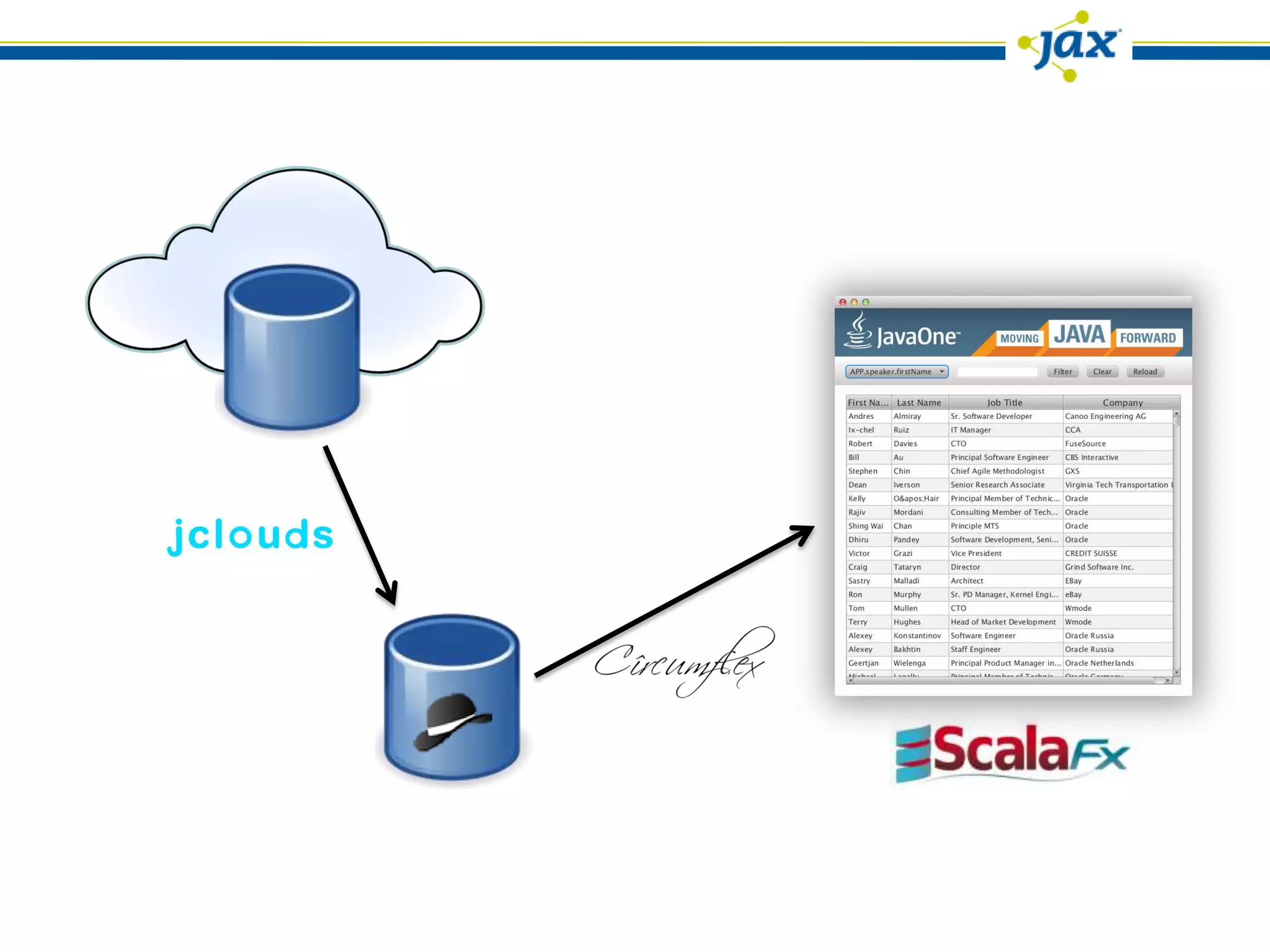

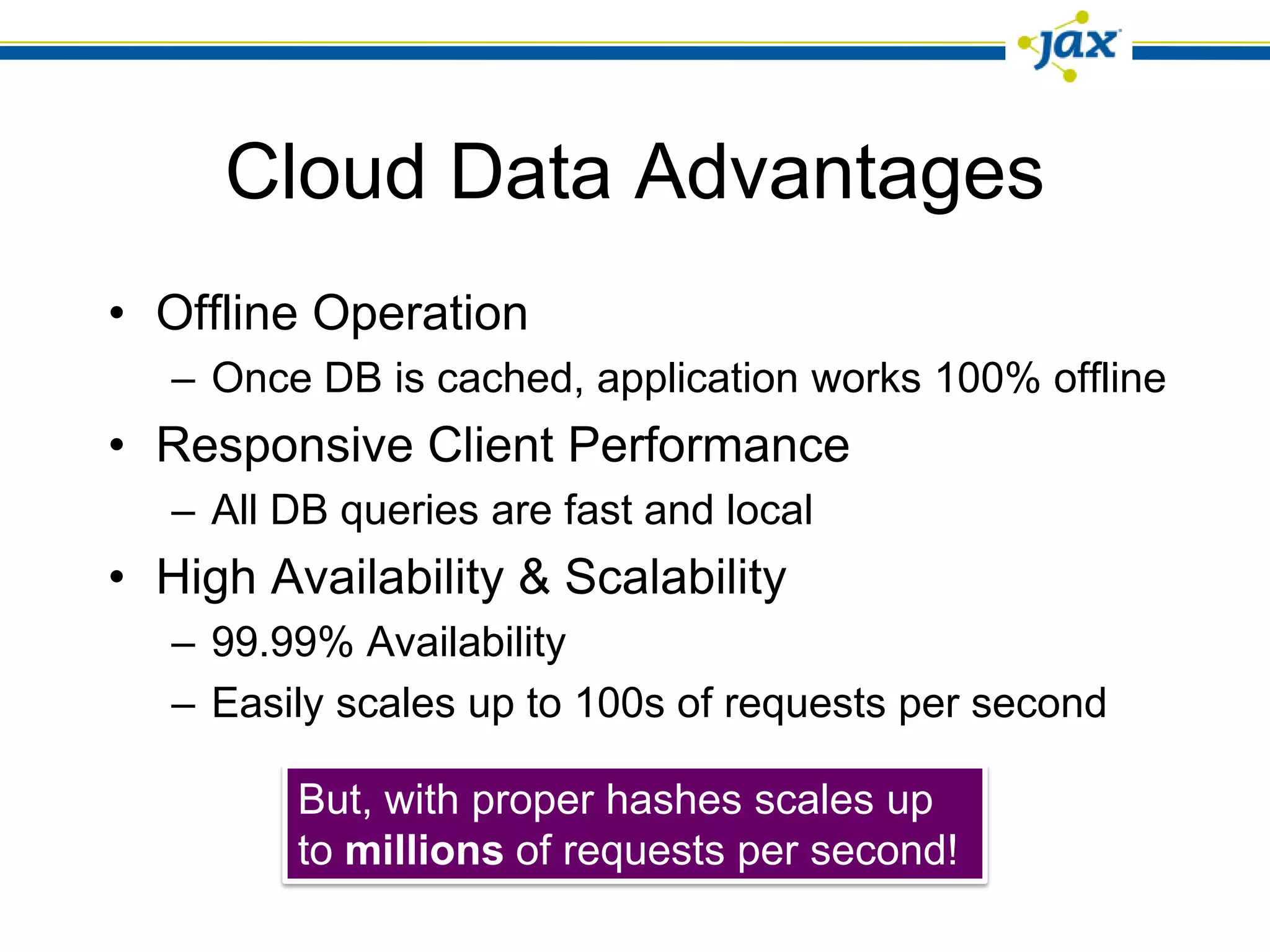


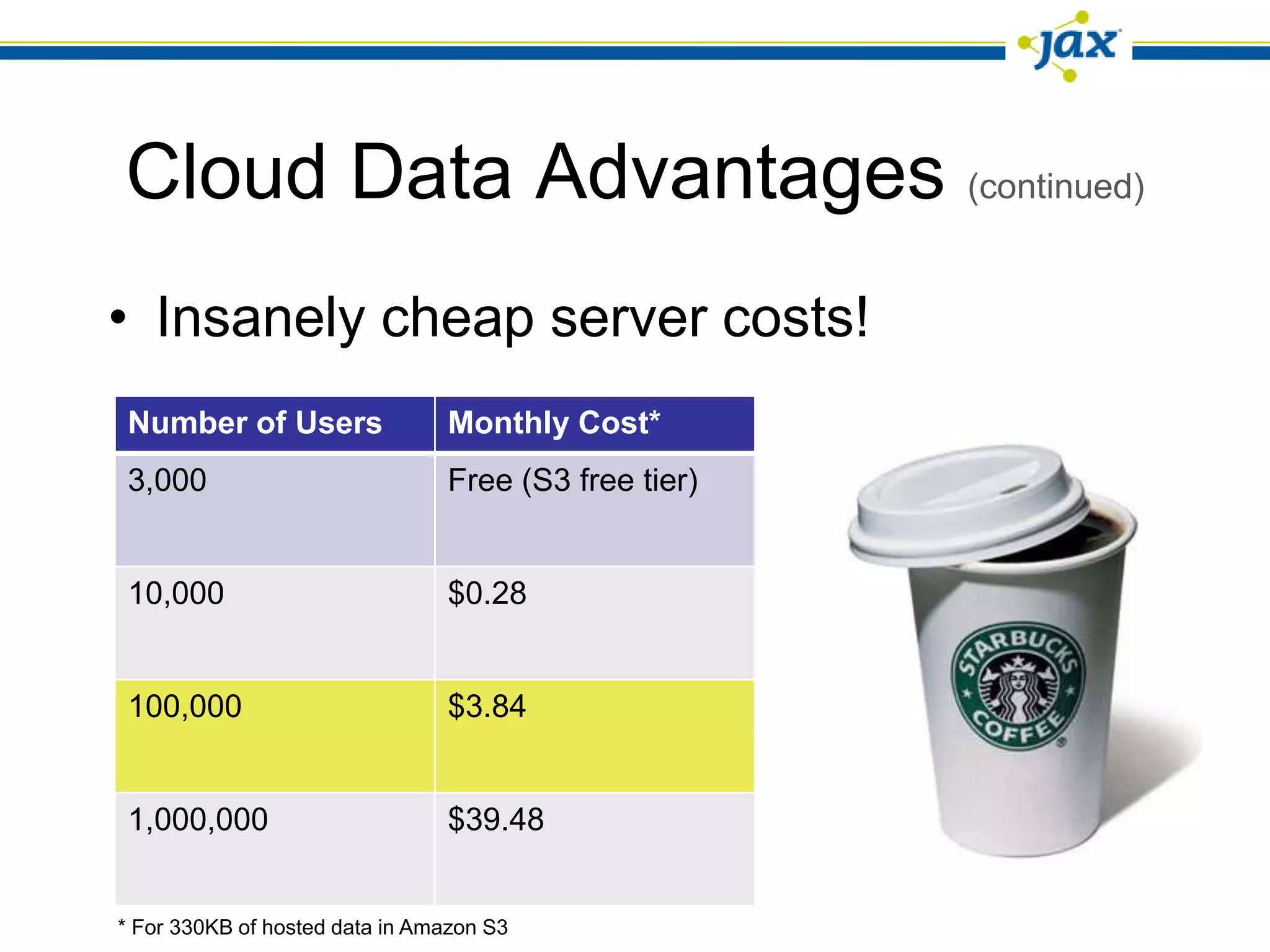

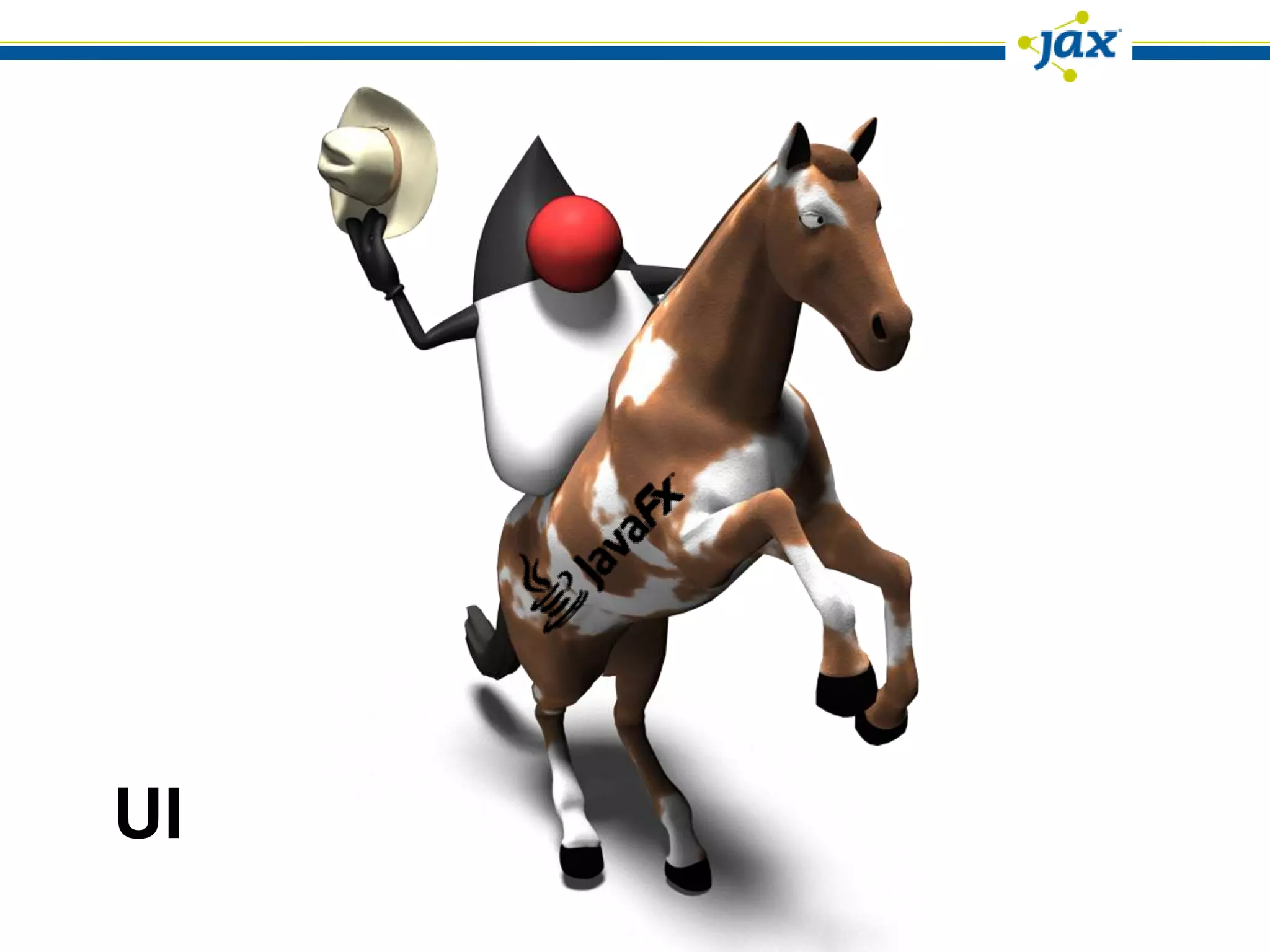
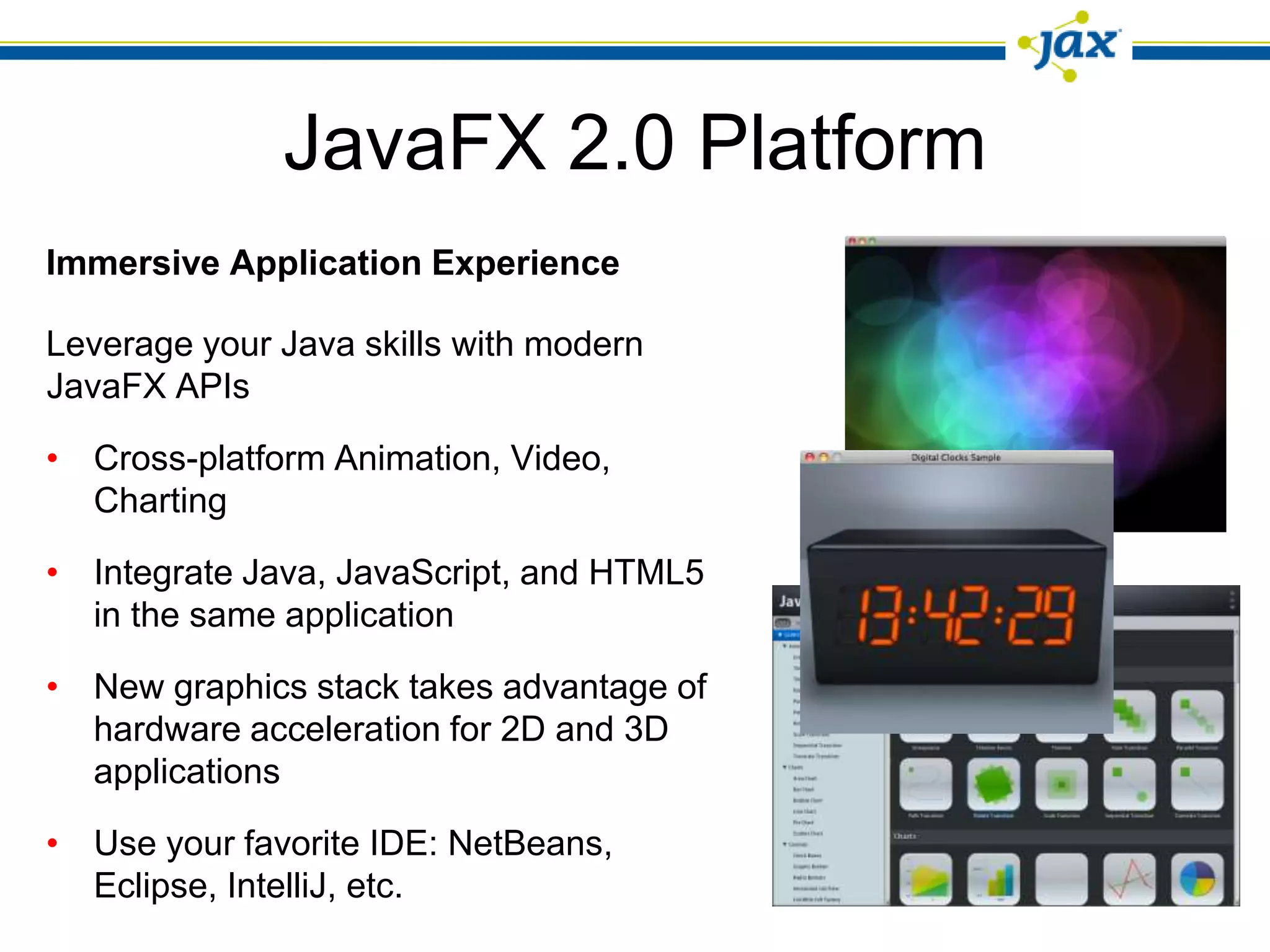


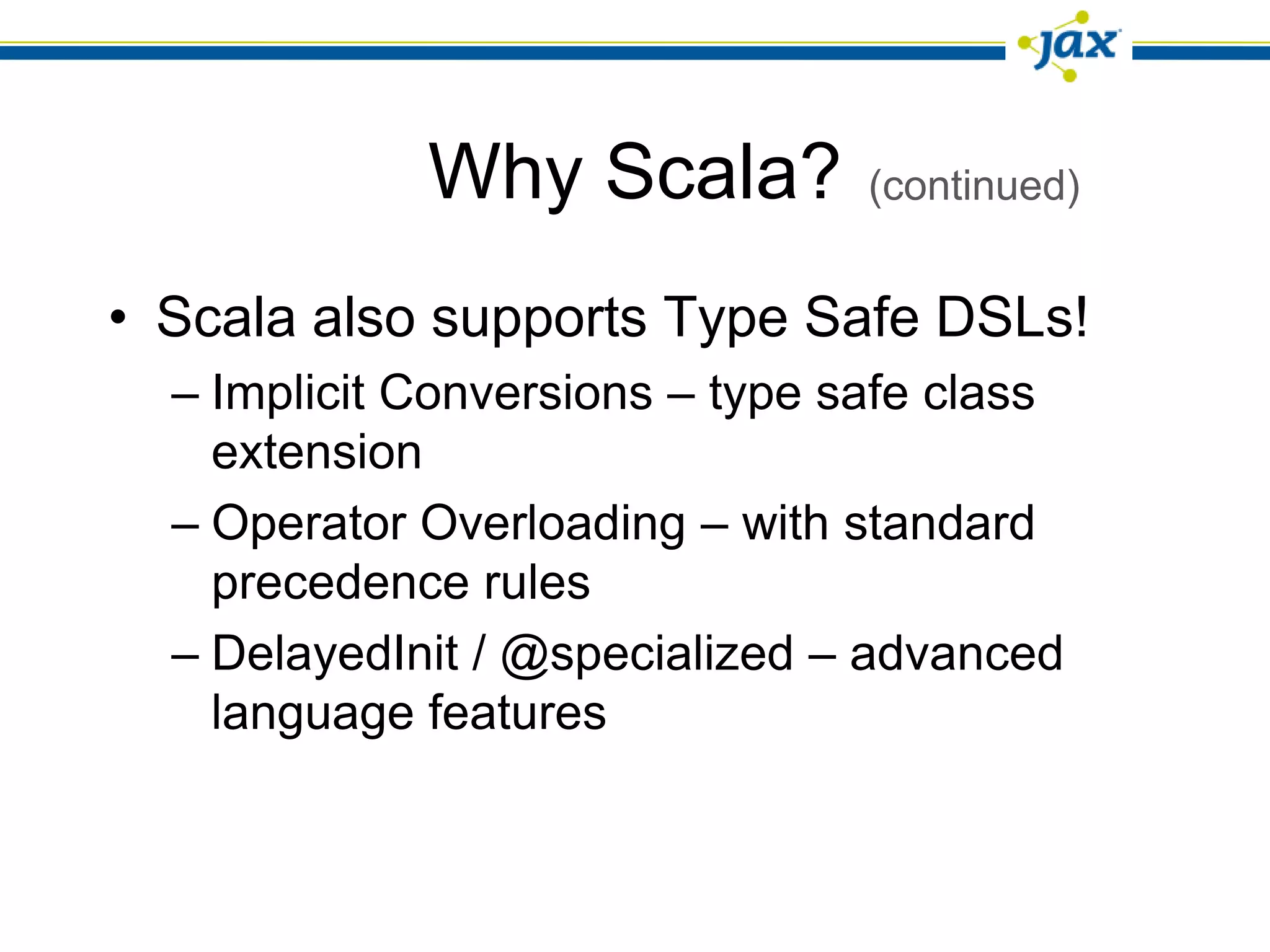
![Java vs. Scala DSL public class JavaFXEEDemo extends Application { object ConferenceUI extends JFXApp { val model = ConferenceModel public static void main(String[] args) { stage = new Stage { launch(JavaFXEEDemo.class, args); width = 625 } height = 700 scene = new Scene(new StackPane()) { private SpeakerModel speakerModel = getInstance(); fill = "#fcfcfc" private TextField filter; children = Seq( private ChoiceBox<String> items; new VBox { children = Seq( @Override new ImageView { public void start(Stage primaryStage) { image = new Image(getClass().getResourceAsStream("JavaOneLogo.png")) primaryStage.setTitle("JavaOne Speaker List"); }, speakerModel.load(); new Rectangle { EventHandler<ActionEvent> filterAction = new EventHandler<ActionEvent>() { width = 625 public void handle(ActionEvent event) { height = 50 String field = items.selectionModelProperty().getValue().getSelectedItem(); fill = new LinearGradient( String text = filter.getText(); endX = 0, speakerModel.filter(field, text); stops = Stops(WHITE, "#d0cbc8") } ) }; } primaryStage.setScene(SceneBuilder.create() ) .width(625) }, .height(700) new VBox { .fill(Color.web("#fcfcfc")) padding = Insets(100, 20, 20, 20) .root(StackPaneBuilder.create().children( spacing = 30 // Background image and gradient children = Seq( VBoxBuilder.create().children( new HBox { ImageViewBuilder.create() val filter = new TextField(); 83 Lines 88 Lines .image(new Image(getClass().getResourceAsStream("JavaOneLogo.png"))).build(), val items = new ChoiceBox[ruco.TextField[Speaker]]() { RectangleBuilder.create().width(625).height(50).fill(LinearGradientBuilder.create().endX(0).stops( items = ObservableBuffer(Speaker.firstName, Speaker.lastName, Speaker.jobTitle, Speaker.company) StopBuilder.create().color(Color.WHITE).offset(0).build(), converter = StringConverter.toStringConverter({s:ruco.TextField[Speaker] => s.name}) StopBuilder.create().color(Color.web("#d0cbc8")).offset(1).build() } ).build()).build() alignment = Pos.BASELINE_LEFT ).build(), spacing = 15 // Foreground controls children = Seq( VBoxBuilder.create() items, 2622 Characters 1452 Characters .padding(new Insets(100, 20, 20, 20)) filter, .spacing(30) new Button("Filter") { .children(HBoxBuilder.create() onAction = { e:ActionEvent => .alignment(Pos.BASELINE_LEFT) model.filter(items.selectionModel().getSelectedItem(), filter.text()) .spacing(15) } .children( }, items = new ChoiceBox<String>( new Button("Clear") { FXCollections.observableArrayList(FIRST_NAME, LAST_NAME, JOB_TITLE, COMPANY) onAction = { e:ActionEvent => ), filter.text = "" filter = TextFieldBuilder.create().prefColumnCount(20).onAction(filterAction).build(), model.clear() ButtonBuilder.create().text("Filter").onAction(filterAction).build(), } ButtonBuilder.create().text("Clear").onAction(new EventHandler<ActionEvent>() { }, public void handle(ActionEvent event) { new Button("Reload") { speakerModel.clearFilter(); onAction = { e:ActionEvent => } filter.text = "" }).build(), model.load() ButtonBuilder.create().text("Reload").onAction(new EventHandler<ActionEvent>() { } public void handle(ActionEvent event) { } speakerModel.load(); ) } items.selectionModel().selectFirst() }).build() }, ).build(), new TableView[Speaker](model.filteredSpeakers) { TableViewBuilder.<Speaker>create().items(speakerModel.getFilteredData()).prefHeight(1000).columns( columns = Seq( TableColumnBuilder.<Speaker, String>create() new TableColumn[Speaker, String] { .text(FIRST_NAME) text = "First Name" .cellValueFactory(new PropertyValueFactory<Speaker, String>(FIRST_NAME_FIELD)).build(), converter = {_.firstName()} TableColumnBuilder.<Speaker, String>create() }, .text(LAST_NAME) new TableColumn[Speaker, String] { .cellValueFactory(new PropertyValueFactory<Speaker, String>(LAST_NAME_FIELD)).build(), text = "Last Name" TableColumnBuilder.<Speaker, String>create() converter = {_.lastName()} .text(JOB_TITLE) }, .prefWidth(200) new TableColumn[Speaker, String] { .cellValueFactory(new PropertyValueFactory<Speaker, String>(JOB_TITLE_FIELD)).build(), text = "Job Title" TableColumnBuilder.<Speaker, String>create() converter = {_.jobTitle()} .text(COMPANY) prefWidth = 200 .prefWidth(212) }, .cellValueFactory(new PropertyValueFactory<Speaker, String>(COMPANY_FIELD)).build() new TableColumn[Speaker, String] { ).build() text = "Company" ).build() converter = {_.company()} ).build() prefWidth = 212 ).build() } ); ) items.getSelectionModel().selectFirst(); prefHeight = 1000 primaryStage.show(); } } ) } } ) } onCloseRequest = {_:Any => Platform.exit} } }](https://image.slidesharecdn.com/javafxandscalainthecloud-120714224007-phpapp01/75/JavaFX-and-Scala-in-the-Cloud-17-2048.jpg)
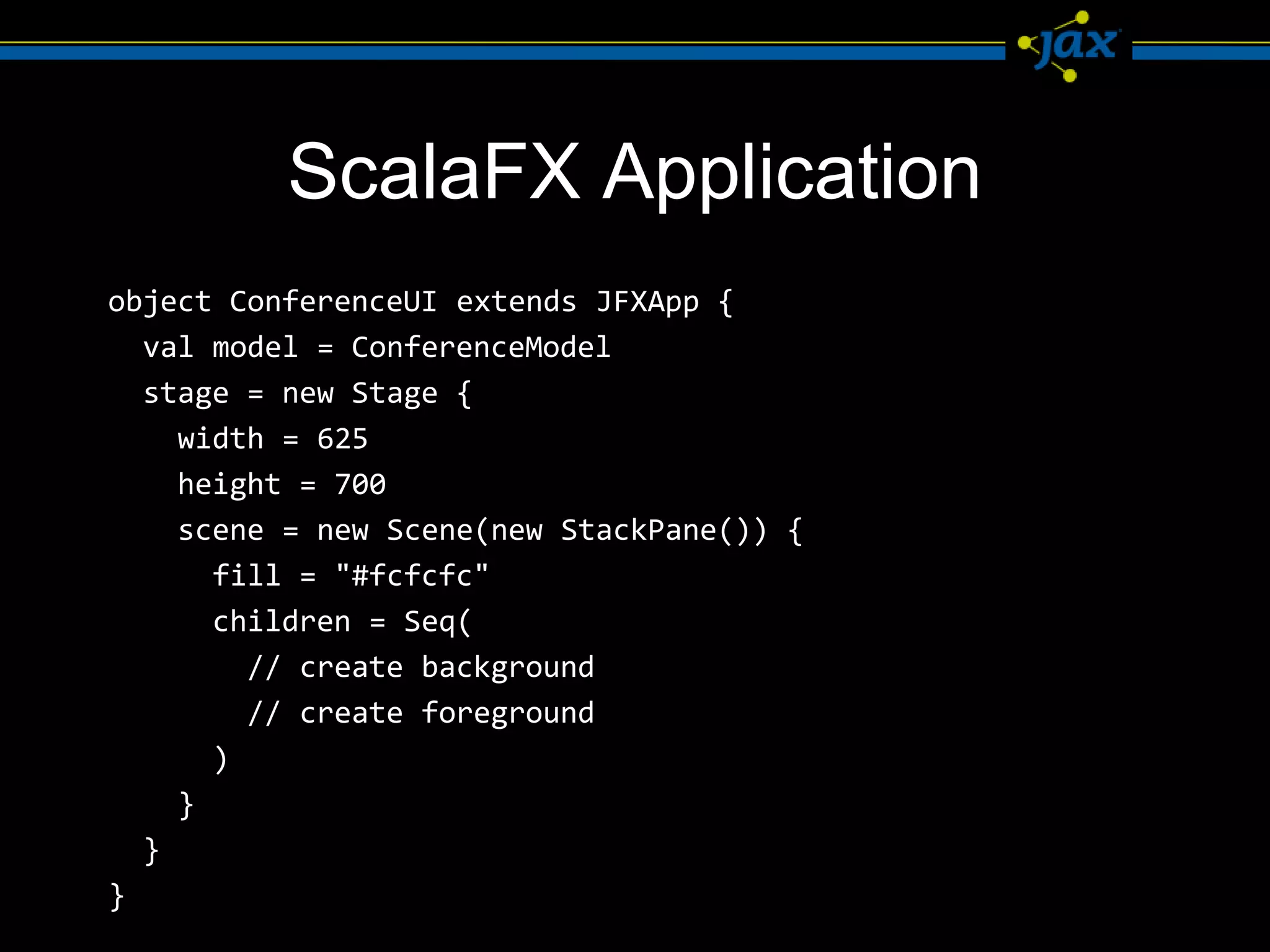
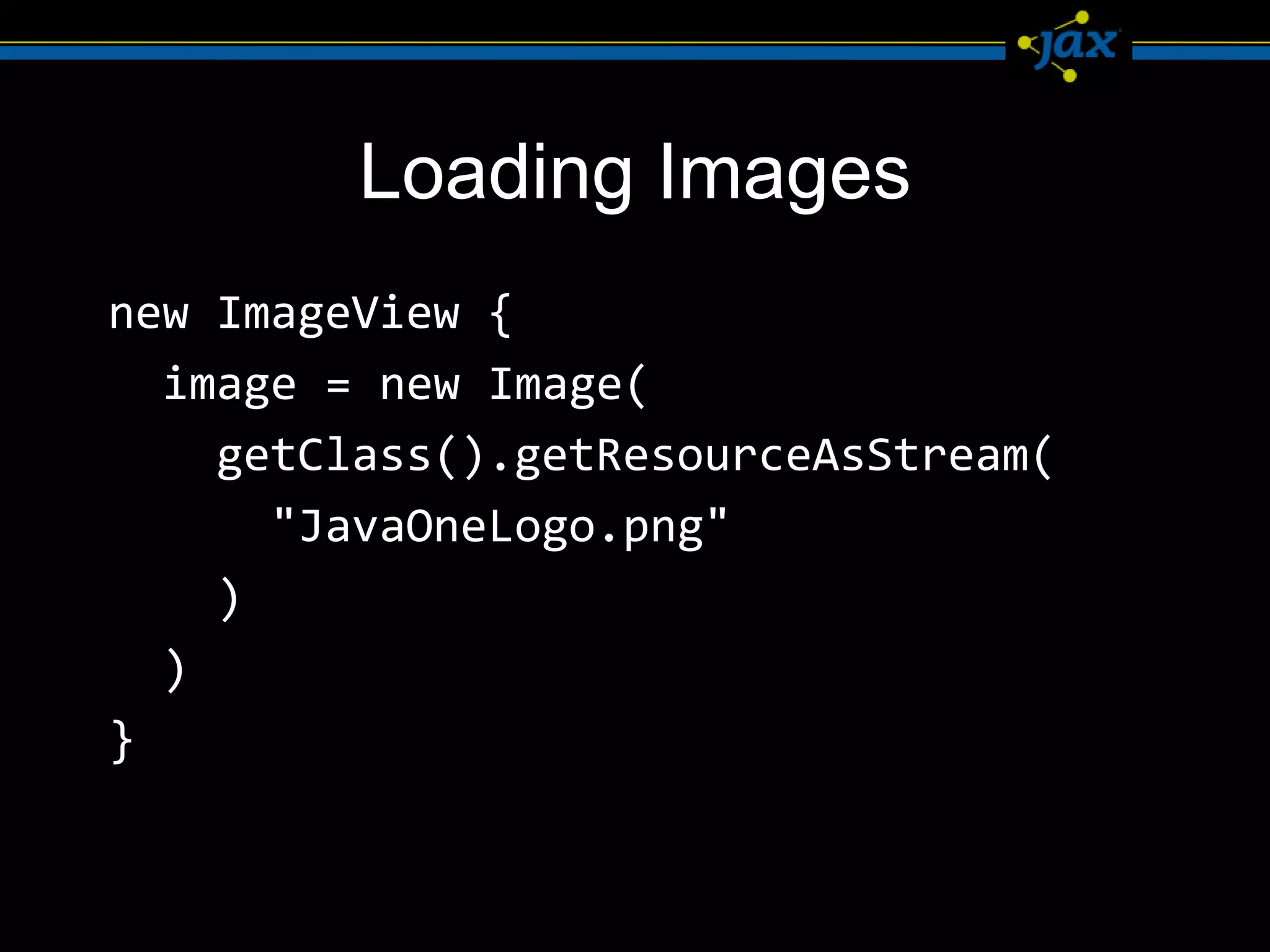
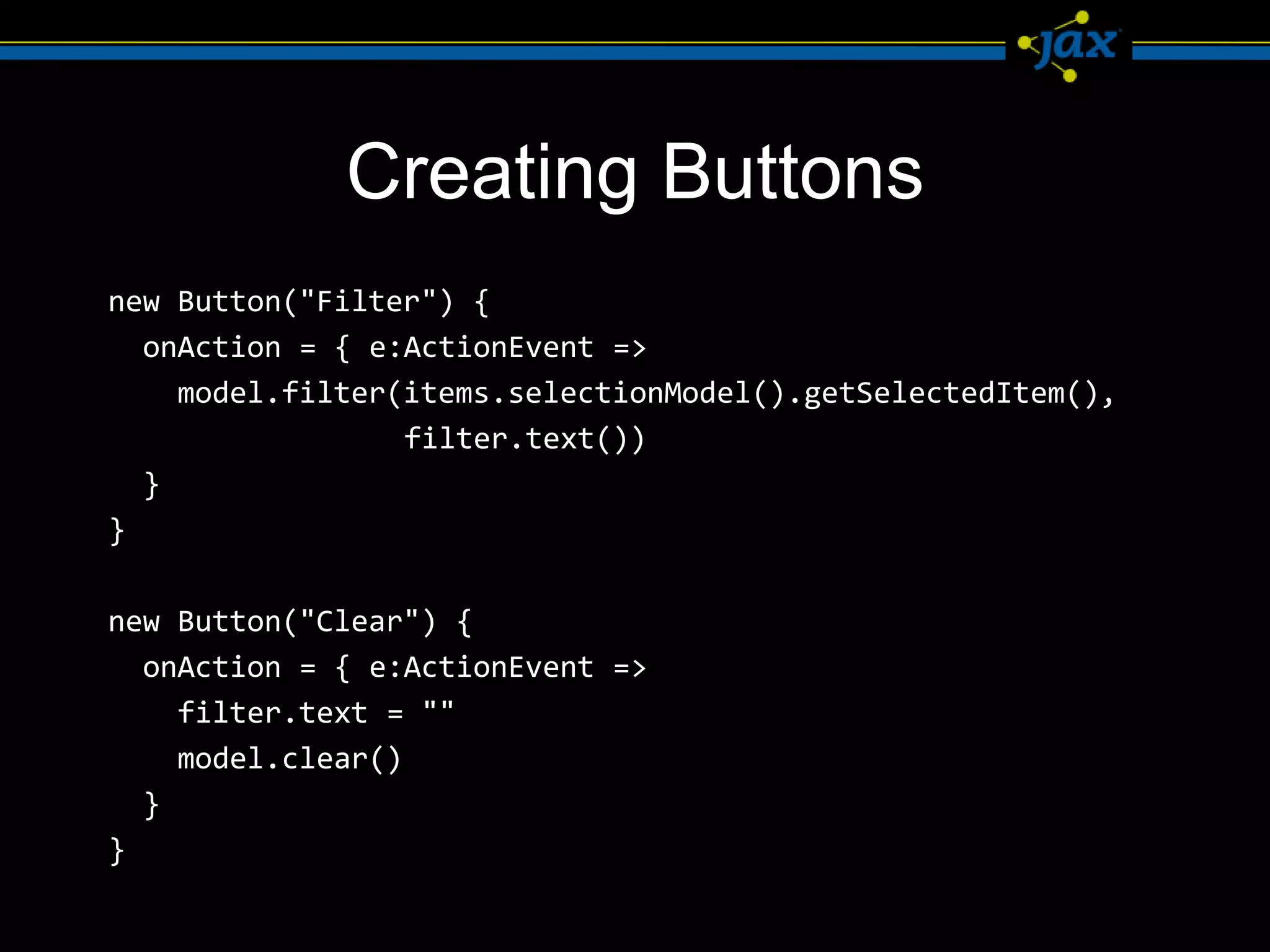
 { columns = Seq( new TableColumn[Speaker, String] { text = "First Name" converter = {_.firstName()} }, new TableColumn[Speaker, String] { text = "Last Name" converter = {_.lastName()} } … ) prefHeight = 1000 }](https://image.slidesharecdn.com/javafxandscalainthecloud-120714224007-phpapp01/75/JavaFX-and-Scala-in-the-Cloud-21-2048.jpg)
![DATABASE By RRZEicons (Own work) [CC-BY-SA-3.0 (http://creativecommons.org/licenses/by-sa/3.0)], via Wikimedia Commons](https://image.slidesharecdn.com/javafxandscalainthecloud-120714224007-phpapp01/75/JavaFX-and-Scala-in-the-Cloud-22-2048.jpg)
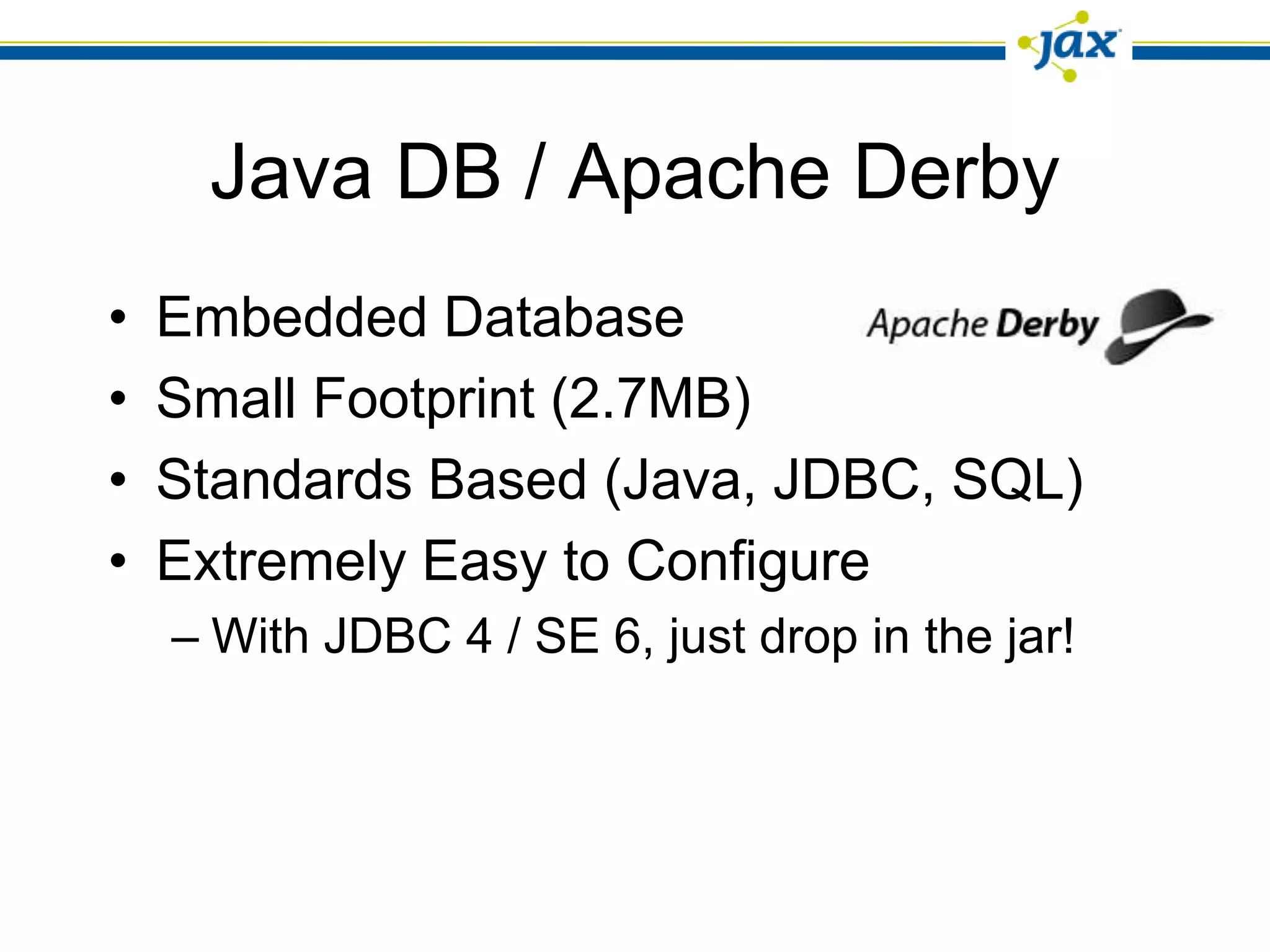
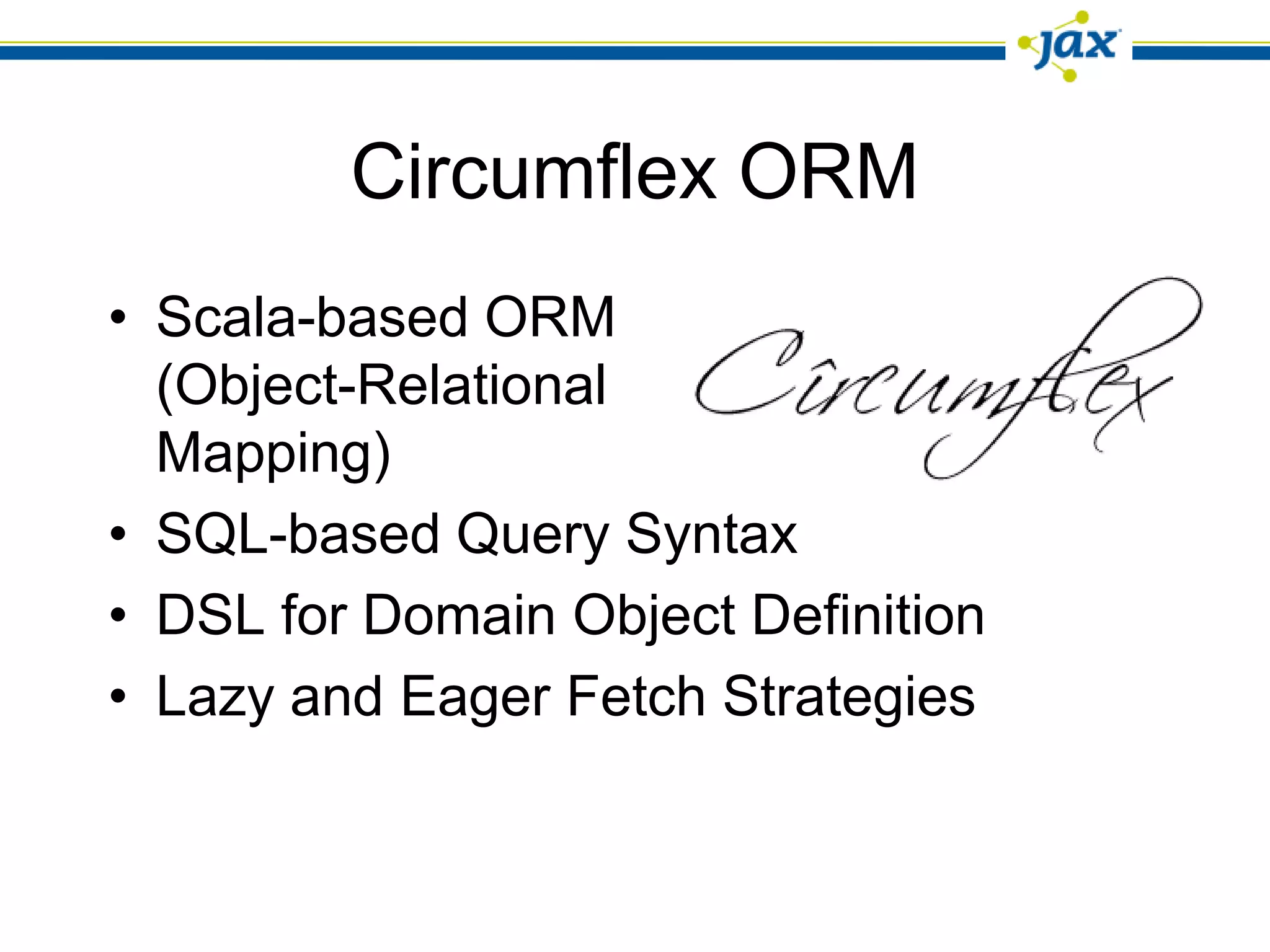
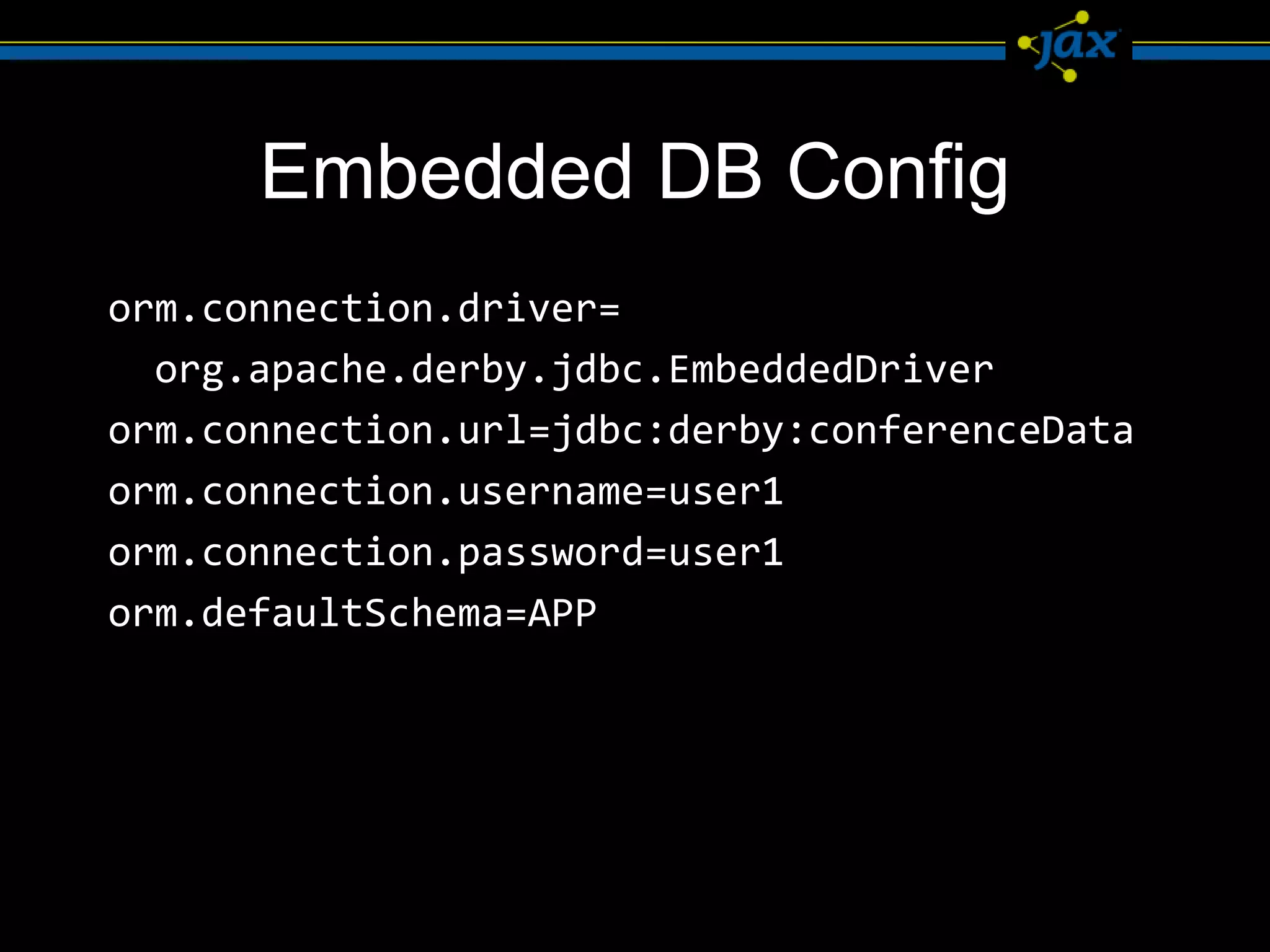
![Speaker Domain Object class Speaker extends Record[String, Speaker] { val id = "id".VARCHAR(255).NOT_NULL val company = "company".VARCHAR(255) val firstName = "firstName".VARCHAR(255) val jobTitle = "jobTitle".VARCHAR(255) val lastName = "lastName".VARCHAR(255) def PRIMARY_KEY = id def relation = Speaker } object Speaker extends Speaker with Table[String, Speaker]](https://image.slidesharecdn.com/javafxandscalainthecloud-120714224007-phpapp01/75/JavaFX-and-Scala-in-the-Cloud-26-2048.jpg)
![Query the Database def clear() { val speakers = Speaker.criteria.list() filteredSpeakers.setAll(speakers) } def filter(field: TextField[Speaker], filterString: String) { val speakers = Speaker.criteria.add( field LIKE "%" + filterString + "%").list() filteredSpeakers.setAll(speakers) }](https://image.slidesharecdn.com/javafxandscalainthecloud-120714224007-phpapp01/75/JavaFX-and-Scala-in-the-Cloud-27-2048.jpg)



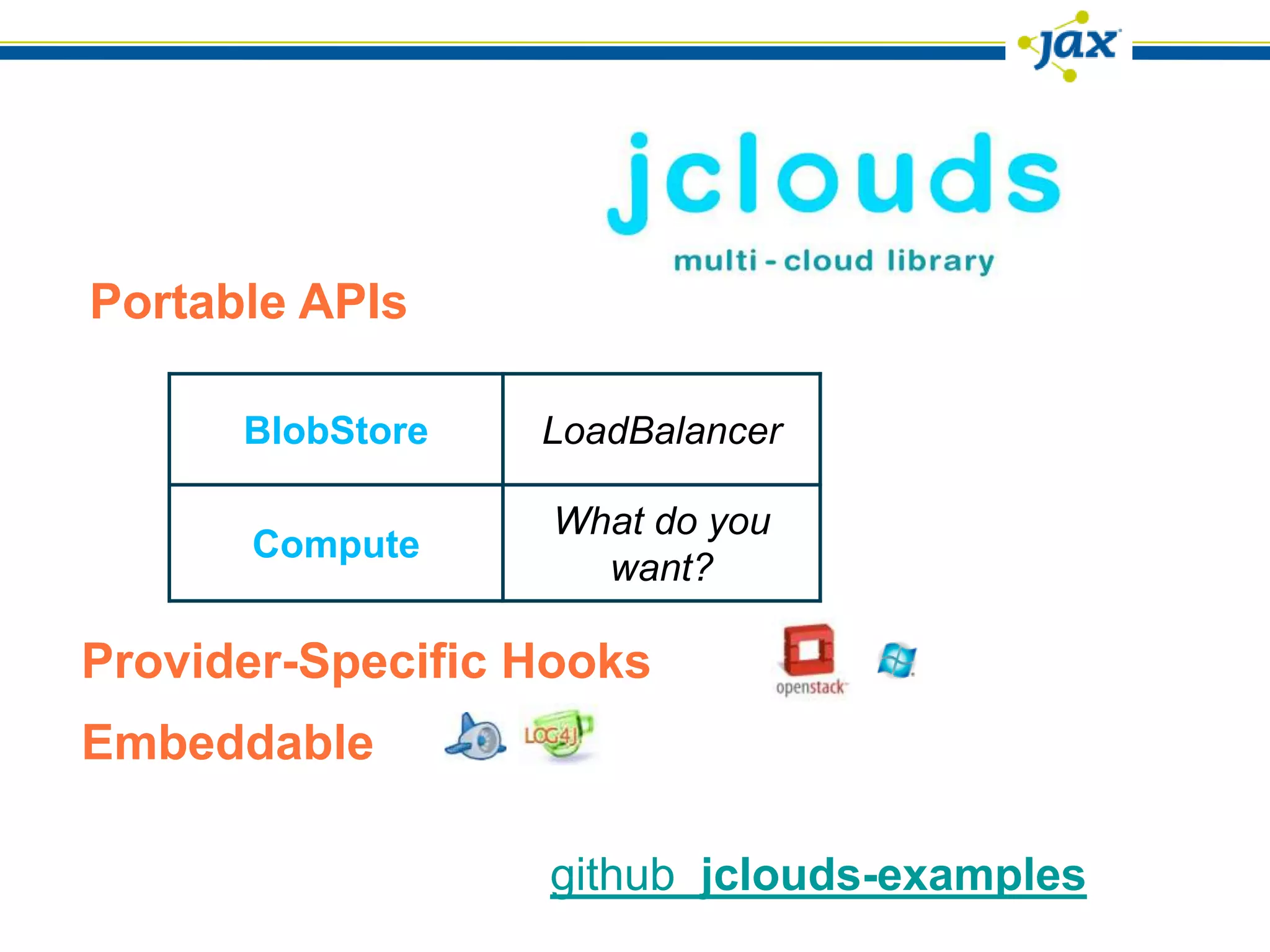


![Cloud Access in Scala val context = ContextBuilder.newBuilder("aws-s3") .credentials("identity", "secret") .buildView(classOf[BlobStoreContext]) def loadFromCloud(container:String, resource:String):InputStream = { val blobStore = context.getBlobStore val blob = blobStore.getBlob(container, resource) blob.getPayload.getInput } def close() { context.close() }](https://image.slidesharecdn.com/javafxandscalainthecloud-120714224007-phpapp01/75/JavaFX-and-Scala-in-the-Cloud-34-2048.jpg)

